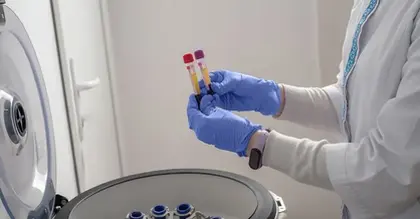
- NAD is a molecule found in every living cell of the body that plays an important role in creating energy in the body.
- Researchers from the University of Bergen, for the first time, show how mitochondria act as “reservoirs” to hold NAD, which plays an important role in creating energy in the body.
- Scientists believe this finding may lead the way for new therapeutic options to combat aging and age-related diseases.
Nicotinamide adenine dinucleotide (NAD) is a molecule found in every living cell of the body. Made from vitamin B3 — also known as niacin — NAD plays an important role in creating energy in the body, as well as repairing DNA.
“NAD is an essential molecule that plays critical roles in all living cells — bacteria, plants, (and) animals,” Mathias Ziegler, MD, PhD, a professor in the Department of Biomedicine at the University of Bergen in Norway explained to Medical News Today.
“The fundamental role of NAD is in the retrieval of energy from food sources to make it available for cellular functions. Metaphorically speaking, NAD acts like a rechargeable battery storing energy retrieved from nutrients and then passing it on to fuel energy-demanding processes. The most important of such processes takes place in mitochondria, the cell’s powerhouse,” he continued.
Ziegler is the lead author of a new study that explains how mitochondria act as “reservoirs” to store NAD for cells to use.
However, as the amount of NAD in the mitochondrial “reservoirs” depletes with age, cells may not have enough NAD to function adequately.
Scientists believe this finding may lead to new therapeutic options aimed at raising NAD levels to combat aging and age-related diseases.
The study was recently published in the journal
For this study, Ziegler and his team developed cellular models to look at how cells might react when NAD levels are reduced during the aging process.
Past research shows that NAD levels decline as we age, potentially causing increased levels of DNA damage and decreased cellular metabolism, both of which are linked to the aging process.
“Throughout the cell, NAD is also used as a chemical messenger to transmit information and to set switches to regulate key events such as cell division and DNA repair,” Ziegler explained.
“Unlike in the energy transmission function, when acting as a messenger molecule, NAD is degraded and needs to be resynthesized. In a variety of diseases, including
“In our study, we established and investigated for the first time a cellular model system that resembled the situation of chronically diminished NAD levels, thereby enabling us to study the mechanistic consequences,” he added.
During the study, researchers found that mitochondria act as a “reservoir” to hold NAD and supply it to the cell as needed.
“Previous studies had demonstrated that mitochondrial NAD plays an important protective role in situations of cellular stress,” Ziegler said. “However, how NAD exerts this role has remained unknown. Our investigation revealed that mitochondria can supply NAD when the demand for this molecule is excessive in other parts of the cell.”
Ziegler and his team also discovered that if mitochondria does not have enough NAD stored up, it can have a fatal consequence for the cell.
“Our study connects two hallmarks of aging, mitochondrial dysfunction and dysregulated NAD levels, indicating that excessive consumption of mitochondrial NAD might constitute a key factor leading to dysfunctional mitochondria and thus aging-associated diseases.”
— Mathias Ziegler, MD, PhD
“Our study has made an important contribution towards understanding the mechanistic basis for positive outcomes of various preclinical and some clinical studies of NAD supplementation approaches. Even though it is unlikely that such supplementation approaches will be able to cure the pathology, they could have positive effects on disease progression (i.e. slowing down progression) and dampening the symptoms,” Ziegler explained.
“This is also likely to be the case in aging, when the mitochondrial NAD reservoir is still sufficiently functional. Since we were able to identify the key players in the buffering function of mitochondria, we unraveled potential molecular targets for the development of therapeutic approaches specifically supporting this mechanism,” he added.
MNT had the opportunity to speak to Manisha Parulekar, MD, FACP, AGSF, CMD, director of the Division of Geriatrics at Hackensack University Medical Center and co-director of the Center for Memory Loss and Brain Health at Hackensack University Medical Center in New Jersey, about this study.
“NAD+ (the oxidized version of NAD) is a crucial coenzyme involved in hundreds of metabolic reactions, particularly those related to energy production, DNA repair, and cell signaling. It is not surprising that dysregulation of NAD+ levels, specifically a decline with age, is increasingly recognized as a possible significant contributor to both aging and a wide range of pathologies,” Parulekar said.
“While significant progress has been made in understanding the role of NAD+ in aging and disease, several key areas require further research. Could supplementing NAD precursors halt this process, what is the optimal dose for different age groups and health conditions? Research should explore how factors like age, sex, genetics, and underlying health conditions influence the response to NAD+ precursors.”
— Manisha Parulekar, MD, FACP, AGSF, CMD
MNT also spoke with Clifford Segil, DO, neurologist at Providence Saint John’s Health Center in Santa Monica, CA, about this study.
“NAD (is) a supplement that is closely related to vitamin B3 or niacin, and niacin is a supplement that we use to lower cholesterol,” Segil said.
“Part of what they said was that NAD in the study is related to mitochondrial problems. In neurology, mitochondrial problems are usually neuromuscular or muscle problems, so (it’s) pretty much accepted mitochondrial problems affect muscles in neurology. It’s not accepted that mitochondria affect dementia in neurology,” he explained.
“I’d like to see them say what dietary changes could try to increase NAD as we age. I’d also like to see them do NAD research on mitochondrial or muscle diseases because in neurology, mitochondrial diseases are most prevalent in muscular neurological problems,” he added,
Parulekar said that while completely halting the age-related decline of NAD+ is likely impossible, readers can take steps to mitigate the decline and maintain Healthier levels.
“Strategies may include consuming foods rich in NAD+ precursors like dairy products, fish, poultry, (and) green vegetables. Daily exercise can also help stimulate mitochondrial biogenesis and increase energy demand,” she detailed.
Segil urged readers to consider oral NAD supplements rather than infusions for safety reasons.
NAD supplements vs. infusions“Anytime you get a supplement infusion, which is an IV done outside of a hospital, there are large risks for infections, so I discourage any patient to get an IV or an infusion of any supplement. I think it’s safer just to continue oral supplements with vitamins and minerals. IV infusions of vitamins and supplements carries the risk of infection, and the risks of infection outweigh any potential benefits.”
— Clifford Segil, DO
“It is important to consult with a healthcare professional before starting any NAD+ supplementation regimen, especially if you have any underlying health conditions. They can help you interpret the existing research and determine whether NAD+ supplementation is appropriate for you,” Parulekar added.





